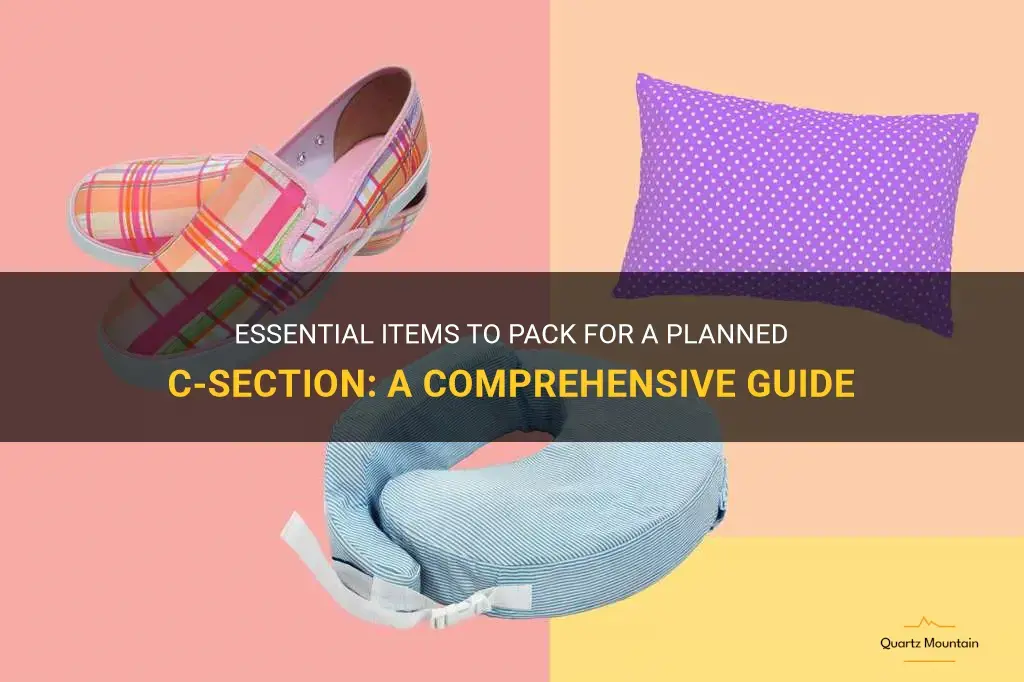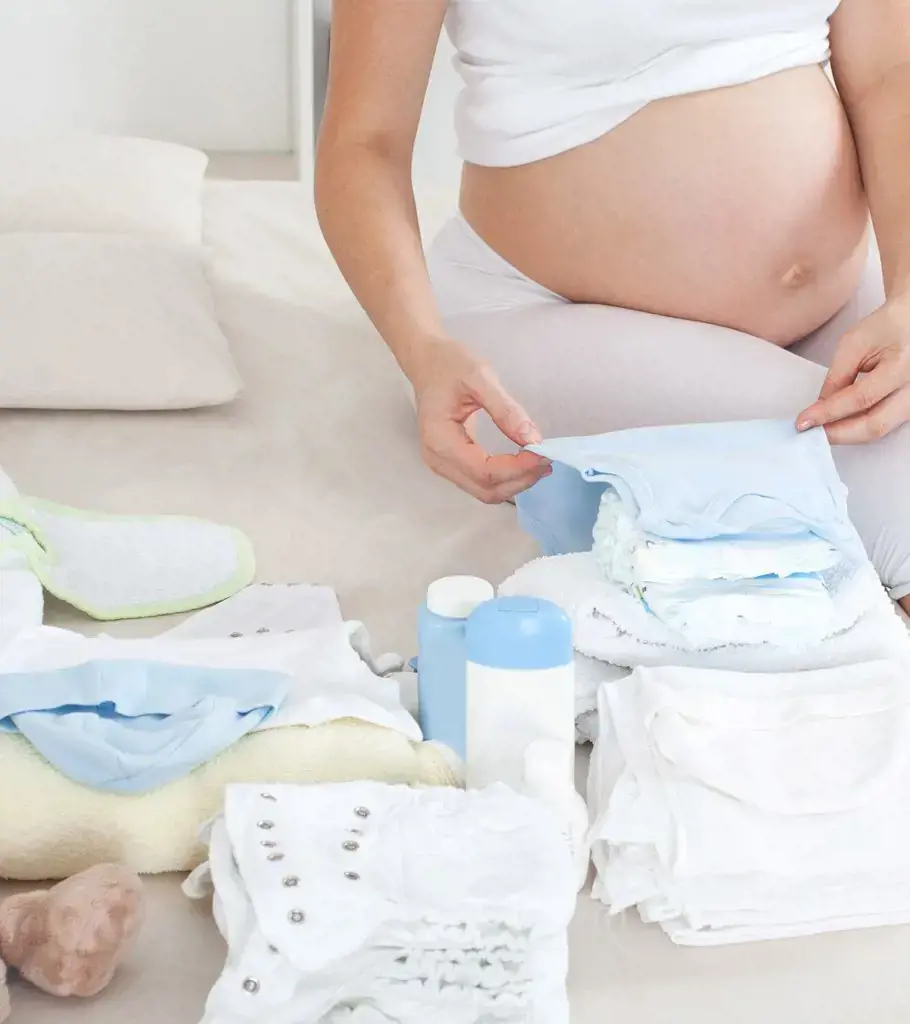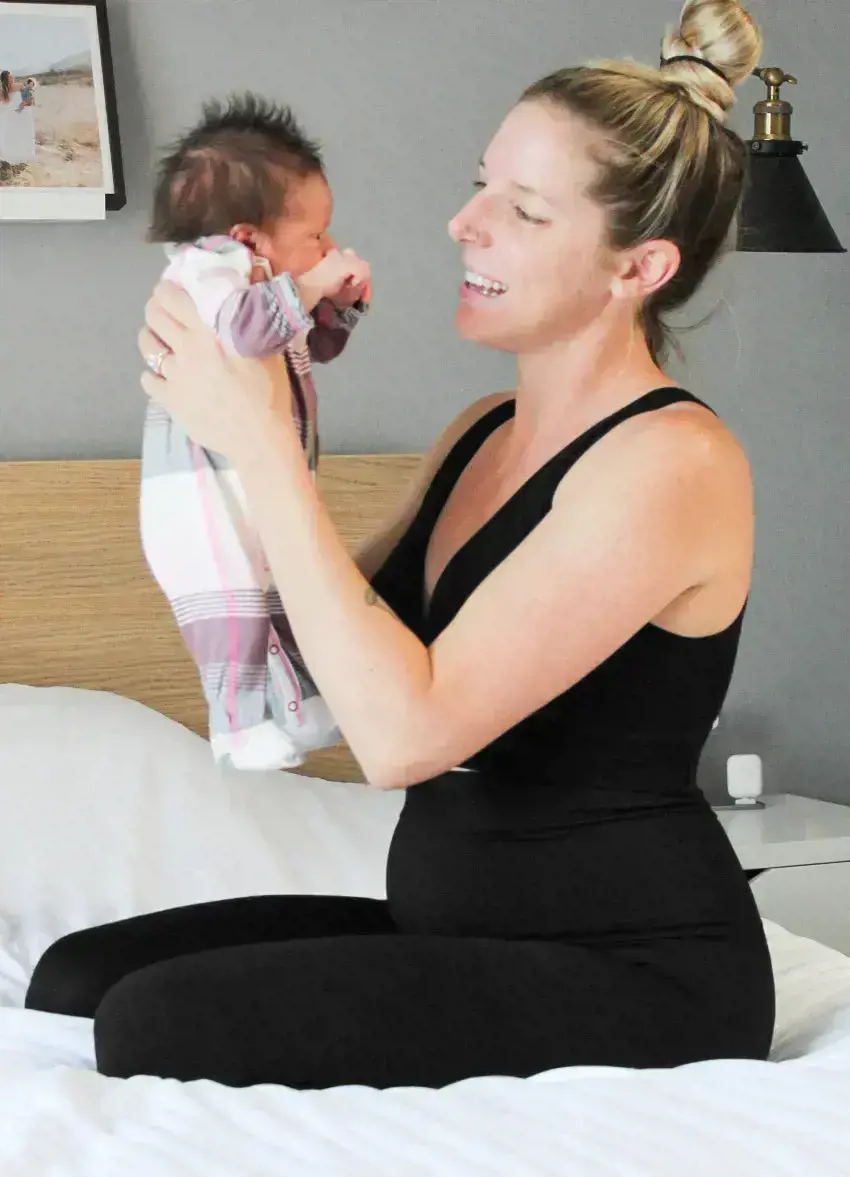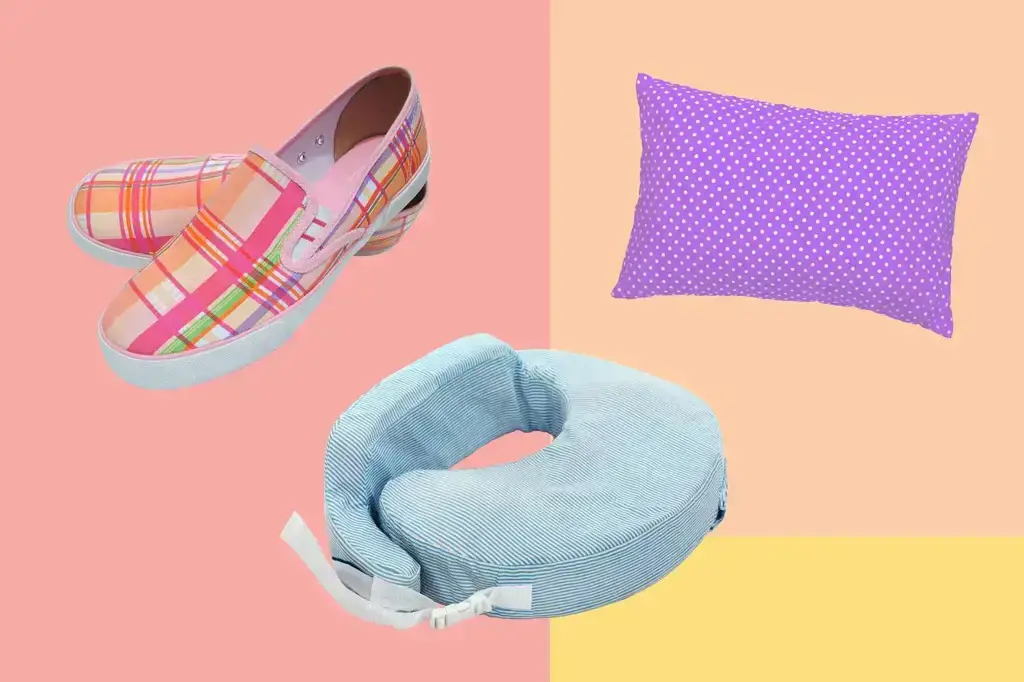
Planning for a C-section can feel overwhelming, but with the right preparation, you can ensure a smooth and comfortable recovery. One crucial aspect of this preparation is packing essential items that will help you in the days following your surgery. From comfortable clothing to toiletries, this comprehensive guide will walk you through everything you need to pack for a planned C-section, allowing you to focus on your recovery and the joy of welcoming your little one into the world.
What You'll Learn
- What are the essential items to pack for a planned c-section?
- Are there any specific items that are recommended for post-operative care?
- Should I pack extra clothing for myself and the baby in case of an extended hospital stay?
- Are there any items that I should bring specifically for breastfeeding after a c-section?
- Are there any restrictions on what can be packed for a c-section, such as prohibited items or specific regulations?

What are the essential items to pack for a planned c-section?

A planned c-section is a surgical procedure that is scheduled in advance. If you are preparing for a planned c-section, there are a few essential items that you should pack to ensure a smooth and comfortable recovery. Here is a list of items to consider packing for your hospital stay:
Comfortable Clothing:
Pack loose-fitting, comfortable clothing that is easy to put on and take off. This includes pajamas, robes, and comfortable underwear. Opt for breathable fabrics such as cotton to prevent irritation and allow for better air circulation. It is also a good idea to bring a few nursing bras if you plan to breastfeed.
Toiletries:
Pack all your essential toiletries such as toothbrush, toothpaste, soap, shampoo, conditioner, hairbrush, and any other items you typically use in your daily routine. Hospitals will usually provide basic toiletries, but having your own familiar products can make you feel more comfortable during your stay.
Nursing Supplies:
If you plan on breastfeeding, it is important to bring nursing supplies such as breast pads, nipple creams, and a nursing pillow. These items will help you with any discomfort and make nursing easier for both you and your baby.
Pregnancy Pillow:
A pregnancy pillow can be a lifesaver during your hospital stay. It will provide you with extra support and comfort, especially if you need to spend a lot of time in bed. There are different types of pregnancy pillows available, so choose the one that suits your needs the best.
Entertainment:
To help pass the time and distract yourself from any discomfort, bring some entertainment options such as books, magazines, or a tablet. You may also want to pack a charger for your electronic devices.
Snacks:
It's always a good idea to pack some snacks because hospital food may not always be to your liking. Bring nutritious and easy-to-eat snacks such as granola bars, nuts, and dried fruits to keep your energy levels up during your recovery.
Comfortable Footwear:
Pack a pair of comfortable slippers or flip-flops to wear around the hospital. This will allow you to move around more easily and help prevent slipping or falling.
Baby Essentials:
Don't forget to pack essential items for your newborn such as clothing, diapers, wipes, and a going-home outfit. It is a good idea to pack these items separately in a baby bag for easy access.
It is important to note that every hospital may have different policies and guidelines, so it is a good idea to check with your healthcare provider or the hospital beforehand to ensure you have everything you need. Additionally, it is always helpful to have a support person with you during your hospital stay to assist you with any additional items or needs that may arise.
In conclusion, packing the essential items mentioned above will help make your planned c-section recovery more comfortable and provide you with the necessary items for both you and your baby during your hospital stay. Remember to check with your healthcare provider or hospital for any specific recommendations they may have.
Common Mistakes When Packing a Moving Truck: Items You Should Never Include
You may want to see also

Are there any specific items that are recommended for post-operative care?

After undergoing surgery, it is important to take proper care of your body to ensure a smooth recovery. This includes not only following your surgeon's instructions but also investing in certain items that can assist in the post-operative healing process. Here are some specific items that are often recommended for post-operative care:
- Compression garments: Depending on the type of surgery you undergo, your surgeon may suggest wearing compression garments. These special garments apply gentle pressure to the surgical area, helping to reduce swelling and promote proper healing. They are commonly recommended after procedures such as liposuction, breast augmentation, and tummy tucks.
- Ice packs: Ice packs are a simple yet effective way to reduce swelling and alleviate pain after surgery. Applying cold therapy to the surgical site can help constrict blood vessels, decrease fluid accumulation, and provide temporary numbing relief. It is important to follow your surgeon's instructions regarding the frequency and duration of ice pack application to avoid damaging the skin.
- Pillows for elevation: Elevating the surgical area can aid in reducing swelling and promoting proper drainage. Depending on the type of surgery you undergo, you may benefit from using extra pillows to elevate the affected body part while you sleep or rest. For example, after a shoulder surgery, sleeping with a pillow or two under your arm can help reduce discomfort and assist with the healing process.
- Scar treatment products: Many surgeries result in visible scars, which can be concerning for some individuals. Using scar treatment products, such as silicone sheets or gels, can help improve the appearance of scars and promote optimal healing. These products work by hydrating the skin, reducing collagen production, and protecting the area from external irritants.
- Shower chair or stool: To avoid slipping or putting excessive strain on your body, it may be helpful to use a shower chair or stool during your post-operative recovery. This can provide stability and support while allowing you to safely shower without risking injury or discomfort.
- Mobility aids: Depending on your surgery and overall mobility, you may require the use of mobility aids such as crutches, walkers, or canes. These aids not only provide support but also assist in maintaining balance and reducing the risk of falls, especially during the initial stages of recovery.
- Loose and comfortable clothing: Wearing loose, non-restrictive clothing can support post-operative healing by reducing friction and allowing for optimal comfort. This is particularly important if you have incisions or surgical dressings that need to be protected. Opt for soft fabrics that won't irritate the skin and choose clothing with easy-to-fasten closures to avoid unnecessary movement or strain.
Remember, these items are general recommendations, and it is essential to consult your surgeon for personalized advice tailored to your specific surgical procedure and needs. Your surgeon may have additional suggestions or modifications based on your individual circumstances.
In conclusion, investing in specific items for post-operative care can greatly contribute to a smooth recovery and optimal healing. Compression garments, ice packs, pillows for elevation, scar treatment products, shower chairs, mobility aids, and comfortable clothing are among the commonly recommended items. By following your surgeon's instructions and utilizing these products, you can promote a successful post-operative recovery and enhance your overall well-being.
Essential Items to Include in Your Camping Music Festival Packing List
You may want to see also

Should I pack extra clothing for myself and the baby in case of an extended hospital stay?

When preparing for the birth of a baby, packing a hospital bag is an important task to ensure that you have everything you need during your stay. One question that often arises is whether or not to pack extra clothing for yourself and the baby in case of an extended hospital stay. In this article, we will explore the factors to consider when making this decision and provide some guidance.
Firstly, it is worth considering the length of your anticipated hospital stay. Many hospitals offer standard postpartum stays of 24 to 48 hours for uncomplicated vaginal deliveries, and slightly longer for cesarean deliveries. If you anticipate a longer stay due to medical complications or other factors, it may be wise to pack extra clothing.
For yourself, consider the comfort and convenience of having clean clothing readily available. Hospital gowns can be uncomfortable and may not accommodate breastfeeding or other activities. Packing a few extra pairs of comfortable pajamas or loungewear can make your stay more pleasant. Additionally, packing a nursing bra and nursing-friendly shirts can streamline breastfeeding and make it easier for both you and your baby.
When it comes to clothing for the baby, be mindful of the potential need for additional layers and changes of clothes. Newborns are prone to accidental spit-ups, diaper leaks, and other messes that may require a change of clothes. Packing a few extra onesies, sleepers, and receiving blankets can ensure that your baby stays clean and comfortable throughout your stay.
Another consideration when deciding whether to pack extra clothing is the availability of laundry facilities at the hospital. Some hospitals may offer laundry services, while others may not. If you do not have access to laundry facilities, it may be wise to pack extra clothing to ensure that you and your baby always have clean and fresh garments.
Lastly, it is worth considering the convenience of having extra clothing readily available even if your hospital stay is not extended. Birth can be unpredictable, and unexpected circumstances could arise that result in a longer stay than initially anticipated. By packing extra clothing, you can be prepared for any scenario and ensure that you and your baby are comfortable throughout your stay.
In conclusion, while the decision to pack extra clothing for yourself and the baby during a hospital stay is a personal one, there are several factors to consider. If you anticipate a longer stay, prefer the comfort of your own clothing, or want to be prepared for any unexpected circumstances, packing extra clothing can be a wise decision. Ensure that you pack comfortable options for yourself and enough changes of clothes for your baby to accommodate potential messes. By taking these factors into account, you can be prepared for your hospital stay and have a more comfortable and stress-free experience.
Where to Pack What: A Guide to Packing for Air Canada
You may want to see also

Are there any items that I should bring specifically for breastfeeding after a c-section?

Breastfeeding is highly encouraged for new mothers as it provides numerous benefits for both the mother and the baby. However, breastfeeding after a c-section can present some challenges due to the surgical procedure and the recovery period involved. To make the breastfeeding experience smoother and more comfortable, there are a few items that new mothers should consider bringing specifically for breastfeeding after a c-section.
- Nursing Bras: Nursing bras are essential for breastfeeding mothers, as they provide easy access for the baby to latch on and feed comfortably. After a c-section, it is important to opt for bras that have a soft and stretchable fabric to avoid any discomfort or irritation on the incision area. Look for bras with adjustable straps and front closures for easy maneuverability.
- Nursing Pads: Nursing pads are helpful in preventing leaks and keeping the breasts dry. They come in both disposable and reusable options, allowing mothers to choose according to their preference. After a c-section, it may take a few days for the milk supply to fully establish, and nursing pads can help manage any excessive leakage during this time.
- Nursing Pillow: A nursing pillow can be a great investment for c-section mothers, as it helps position the baby in a comfortable and ergonomic way during breastfeeding. The pillow provides support for the baby's head, neck, and body, reducing strain on the mother's incision area. It also helps achieve a proper latch, which is crucial for efficient breastfeeding.
- Nipple Cream: Breastfeeding can sometimes cause sore and cracked nipples, especially during the initial days. Nipple cream can provide relief and promote healing. Look for lanolin-based creams that are safe for the baby and mom. Applying nipple cream after each feeding can prevent discomfort and allow the mother to continue breastfeeding comfortably.
- Water Bottle: Staying hydrated is essential for breastfeeding mothers, as it helps maintain milk supply and overall well-being. After a c-section, it might be challenging to move around frequently to get a glass of water. Having a water bottle within easy reach can encourage mothers to stay hydrated while breastfeeding without having to leave their comfortable position.
- Snacks: Breastfeeding can increase a mother's hunger, as the body requires additional energy to produce milk. Having healthy and nutritious snacks readily available can provide the necessary nourishment and energy during breastfeeding sessions. Opt for snacks high in protein and fiber to keep you feeling satisfied and energized.
- Breast Pump: A breast pump can be beneficial for c-section mothers, as it allows them to express milk and relieve engorgement. In the early postpartum period, breastfeeding can sometimes be challenging due to pain, fatigue, or difficulty with latching. A breast pump can help maintain milk supply and provide a backup feeding option for the baby.
- Supportive Underwear: After a c-section, it is essential to wear comfortable and supportive underwear to provide gentle compression to the abdominal area. Look for postpartum underwear specifically designed for c-section recovery, as they provide support without putting pressure on the incision site. Comfortable underwear ensures that breastfeeding positions are not compromised due to discomfort or pain.
- Lactation Consultant Contact Information: Breastfeeding after a c-section can be challenging, and it is always beneficial to have a lactation consultant's contact information readily available. Lactation consultants can provide guidance, support, and assistance with any breastfeeding difficulties that may arise. They can help address issues such as low milk supply, latching problems, or nipple pain.
Breastfeeding after a c-section may require additional care and attention, but with the right items, support, and preparation, it can be a positive and successful experience. Remember to consult with healthcare professionals or lactation consultants for personalized advice and guidance.
Essential Items to Pack for a Parade: Your Guide to a Fun and Fuss-Free Experience
You may want to see also

Are there any restrictions on what can be packed for a c-section, such as prohibited items or specific regulations?

Preparing for a c-section can seem overwhelming, especially when it comes to packing a hospital bag. While there are no specific regulations or prohibited items for c-sections, there are some general guidelines and recommendations to consider when packing for your surgery. These guidelines prioritize the safety and comfort of both the patient and the medical staff involved.
Here are some essential items you should consider packing for your c-section surgery:
- Comfortable Clothing: After your c-section, you'll want to wear loose-fitting, comfortable clothing. Choose items that are easy to put on and take off, such as loose-fitting pajamas or a nursing nightgown. Avoid clothes with restrictive waistbands or tight-fitting tops that may irritate your incision site.
- Underwear: Pack a few pairs of comfortable underwear, preferably cotton, that won't irritate your incision site. Some women find high-waisted underwear or postpartum panties with extra support to be helpful following a c-section.
- Personal Hygiene Items: Don't forget to pack toiletries such as toothbrush, toothpaste, shampoo, conditioner, and soap. Hospitals usually provide basic toiletries, but having your own preferred products can make you feel more comfortable during your stay.
- Nursing Bras and Breast Pads: If you plan to breastfeed, pack a few nursing bras and breast pads to provide support and absorb any leakage. Make sure the bras are comfortable and well-fitted to avoid any discomfort or irritation.
- Comfortable Shoes: Choose a pair of comfortable, slip-on shoes or slippers that are easy to put on and take off. Your feet may be swollen after the surgery, so avoid shoes that are too tight or restrictive.
- Entertainment: Bring some form of entertainment to keep yourself occupied during your hospital stay. This could be a book, magazine, tablet, or handheld gaming device. It's also a good idea to include chargers for any devices you bring.
- Snacks: While the hospital may provide meals, you may want to bring some of your favorite snacks to have on hand. Check with your healthcare provider beforehand to ensure there are no dietary restrictions or limitations.
When packing for your c-section, it's important to keep in mind that you may need to limit the amount of luggage you bring, as you may have limited space in your hospital room. Additionally, remember that the focus should be on essentials and items that will provide comfort and convenience during your stay.
While there are no specific regulations on what can't be packed for a c-section, it's always a good idea to check with your healthcare provider or hospital to ensure there are no additional restrictions or guidelines that you should be aware of. They can provide you with specific recommendations based on your individual circumstances and the policies of the hospital where you will be having your surgery.
In conclusion, when packing for a c-section, focus on comfortable clothing, personal hygiene items, nursing bras, and entertainment. Avoid packing unnecessary items or anything that may take up too much space. Remember to consult with your healthcare provider for specific recommendations and guidelines based on your individual needs.
Essential Items to Pack for Travel During the Coronavirus Pandemic
You may want to see also
Frequently asked questions
When packing for a planned c-section, it's important to include essential items that will make the recovery process more comfortable. These items include loose and comfortable clothing such as maternity pants or leggings, nursing bras or tank tops, underwear, and soft and loose-fitting tops. You should also pack toiletries like shampoo, conditioner, soap, toothbrush, and toothpaste.
It's best to pack loose and comfortable clothing for your hospital stay after a c-section. This includes items like nightgowns or pajama sets, robe, slippers or socks, and a cozy outfit to wear when going home. It's important to choose clothing that is easy to put on and take off to avoid any discomfort or pain around your incision site.
Yes, there are a few special items you should consider packing specifically for a c-section. These include a belly binder or abdominal support garment, which can help provide additional support and comfort to your incision area. You may also want to bring along a nursing pillow or breastfeeding support pillow to make feeding your baby more comfortable. Additionally, you may want to pack some extra pillows for added support while in the hospital.
While there aren't any specific items for baby that you need to pack for a c-section, it's still important to have the basics ready. This includes items such as diapers, wipes, baby clothes, and a going-home outfit. You may also want to pack a blanket or swaddle for your baby, as well as any breastfeeding supplies you plan to use, such as a breast pump or nursing pads.







